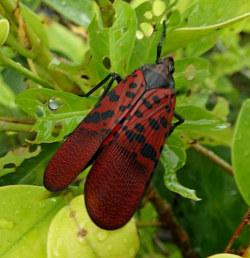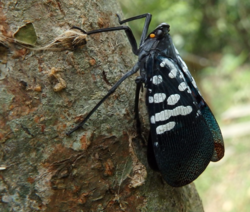Biology:Lycorma meliae
| Lycorma meliae | |
|---|---|

| |
| Adult, red specimen of L. meliae | |

| |
| Adult, dark blue specimen of L. meliae, formerly classified as Lycorma olivacea. | |
| Scientific classification | |
| Domain: | Eukaryota |
| Kingdom: | Animalia |
| Phylum: | Arthropoda |
| Class: | Insecta |
| Order: | Hemiptera |
| Suborder: | Auchenorrhyncha |
| Infraorder: | Fulgoromorpha |
| Family: | Fulgoridae |
| Genus: | Lycorma |
| Species: | L. meliae
|
| Binomial name | |
| Lycorma meliae Kato, 1929
| |
| Synonyms | |
|
Lycorma olivacea Kato, 1929 | |
Lycorma meliae is a planthopper species endemic to Taiwan, with multiple, dramatically different color morphs depending on the life stage. The species was described by Masayo Kato in Taiwan in 1929, and is the only member of its genus confirmed to be native to the island. In 1929, a specimen of L. meliae was originally described as a separate species, L. olivacea, also by Kato. These two taxon names were declared synonymous in 2023. L. meliae undergoes four instar stages before achieving adulthood and specimen generally only survive till the winter.
Taxonomy
L. meliae is a species in the genus Lycorma, in the planthopper family Fulgoridae, subfamily Aphaeninae. Species within this genus are found in Asia.[1] L. meliae, along with its synonym L. olivacea, was described by Masayo Kato in Taiwan in 1929.[2] While initially seen as two separate species, a 2023 report in the Zoological Studies journal concluded that L. meliae and L. olivacea represented two different life stages of the same species. In this reclassification, L. olivacea was redefined as a junior synonym.[3]
Description
Male specimen have a body length that ranges from 22.2 millimetres (0.87 in) to 28.5 millimetres (1.12 in). Female specimen are larger, with a body length ranging from 26.5 millimetres (1.04 in) and 32.2 millimetres (1.27 in). Male tegmen length ranges from 18.9 millimetres (0.74 in) to 25 millimetres (0.98 in); female tegmen length ranges from 23.2 millimetres (0.91 in) to 27.8 millimetres (1.09 in).[3]
The head is short, broad, and angled upward; it ranges from a brown to black. The back of the head is marked with two dark brown segments, both of which have a ridge running down the back. There are two longitudinal ridges also running down each side of these segments. The clypeus is broad and the labium (a part of the mouth) is long but does not reach the abdomen. The antennae are both a marigold orange-yellow. The thorax's pronotum ranges from a brown to black, and is covered in a series of small dark spots. The prothorax and mesothroax are both black. The basal 3/5ths of the tegmen range from a bright red to blue. These sections are covered in black and brown spots that vary in size, and sometimes have a white powder appearance. The rest is covered in a vein pattern.The hindwings vary from pink to light blue, often featuring brown spots and a vein pattern. The upper third of the hindwings are a brown. The legs are generally a dark brown to black. Throughout maturation, L. meliae's wings undergo a series of color changes.[3] They begin a bright red, then transition to reddish brown, brown, deep green, and ending at a dark blue. The abdomen is black. The laterosternites (part of the sternum) and the margins of the tergites are sometimes a marigold orange-yellow.[3]
The male genitalia occupies the 9th, 10th, and 11th abdominal segments. On the 9th segment, the anterior margin is concave and the margins have a series of small projections. The 10th segment is moderately convex, and the apical section is broader than the basal section. This forms a V shape from the side view and a U shape from the top view. The 11th segment is made up of a sternite that is approximately twice the size of the tergite. This segment is an oval shape with hooks on the lateral margins. When mating, the lobes can expand to five times their sheathed length, folding backwards and downwards.[3]
L. meliae is similar in appearance to and has been historically mistaken with Lycorma delicatula, but they can be differentiated based upon eye structure.[3]
Life cycle and ecology
L. meliae is hemimetabolous, meaning that at each molt, the next stage (instar) becomes more like the adult.[4][5] L. meliae does not experience a pupal stage.[6] L. meliae lays its eggs clusters coated in a waxy cuticle, during the late fall to early winter seasons. These eggs develop until late spring when L. meliae nymphs emerge.[7] In total, L. meliae undergoes four instar stages before achieving adulthood.[8]
The chinaberry tree Melia azedarach is a known host for L. meliae.[3] Lycorma meliae, along with the rest of the genus Lycorma, are parasitized by the eupelmid wasp Anastatus orientalis and by Dryinus sinicus, a dryinid wasp.[9]
Distribution and evolution
Lycorma meliae is endemic to the island of Taiwan.[2][10] The following cladogram shows the phylogenetic position of L. meliae among select members of the tribe Aphaenini, based upon comparison of mitochondrial DNA:[11]
| Aphaenini |
| ||||||||||||||||||||||||||||||
References
- ↑ Barringer, Lawrence (17 December 2021). "Lycorma delicatula (spotted lanternfly)". https://www.cabi.org/isc/datasheet/110524#totaxonomicTree.
- ↑ 2.0 2.1 "Planthoppers: FLOW Website". https://flow.hemiptera-databases.org/flow/?page=explorer&db=flow&lang=en&card=taxon&rank=genus&id=8211.
- ↑ 3.0 3.1 3.2 3.3 3.4 3.5 3.6 Lin, You-Sheng; Liao, Jhih-Rong; Shiao, Shiuh-Feng; Ko, Chiun-Cheng (2023). "Lanternflies (Hemiptera: Fulgoridae) of Taiwan". Zoological Studies 62 (7): e7. doi:10.6620/ZS.2023.62-07. PMID 37223434.
- ↑ "Planthoppers" (in en). https://mdc.mo.gov/discover-nature/field-guide/planthoppers.
- ↑ "Lycorma meliae Kato 1929 – Encyclopedia of Life". https://eol.org/pages/241505.
- ↑ "Encyclopedia of Life". https://eol.org/terms/glossary/h/http://eol.org/schema/terms/hemimetabolous.
- ↑ Mason, Robert T.; Fales, Henry M.; Jones, Tappey H.; O'Brien, Lois B.; Taylor, Terry W.; Hogue, Charles L.; Blum, Murray S. (1989-01-01). "Characterization of fulgorid waxes (Homoptera:Fulgoridae:Insecta)" (in en). Insect Biochemistry 19 (8): 737–740. doi:10.1016/0020-1790(89)90054-1. https://dx.doi.org/10.1016/0020-1790%2889%2990054-1. Retrieved 10 September 2022.
- ↑ Chen, Shuo; Yang, Chung-Til (1995). "The metatarsi of the Fulgoroidea (Homoptera: Auchenorrhyncha)". Journal of Entomology 15 (3): 257–269. http://entsocjournal.yabee.com.tw/AllDataPos/JournalPos/VOL15/NO3/TESFE.1995023.PDF.
- ↑ "Genus Lycorma Stal, 1863 | Planthoppers of North America" (in en-US). University of Delaware. n.d.. https://sites.udel.edu/planthoppers/north-america/north-american-fulgoridae/genus-lycorma-stal-1863/.
- ↑ Chen, Wei-Chen. "Lycorma meliae Kato, 1929". Catalogue of life in Taiwan. Biodiversity Research Center, Academia Sinica, Taiwan. http://taibnet.sinica.edu.tw/eng/taibnet_species_detail.php?name_code=425380.
- ↑ Wang, Wenqian; Zhang, Huan; Constant, Jérôme; Bartlett, Charles R.; Qin, Daozheng (30 July 2021). "Characterization, comparative analysis and phylogenetic implications of mitogenomes of Fulgoridae (Hemiptera: Fulgoromorpha)" (in en). Genes 12 (8): 1185. doi:10.3390/genes12081185. PMID 34440359.
External links
Wikidata ☰ Q10571344 entry
 |


